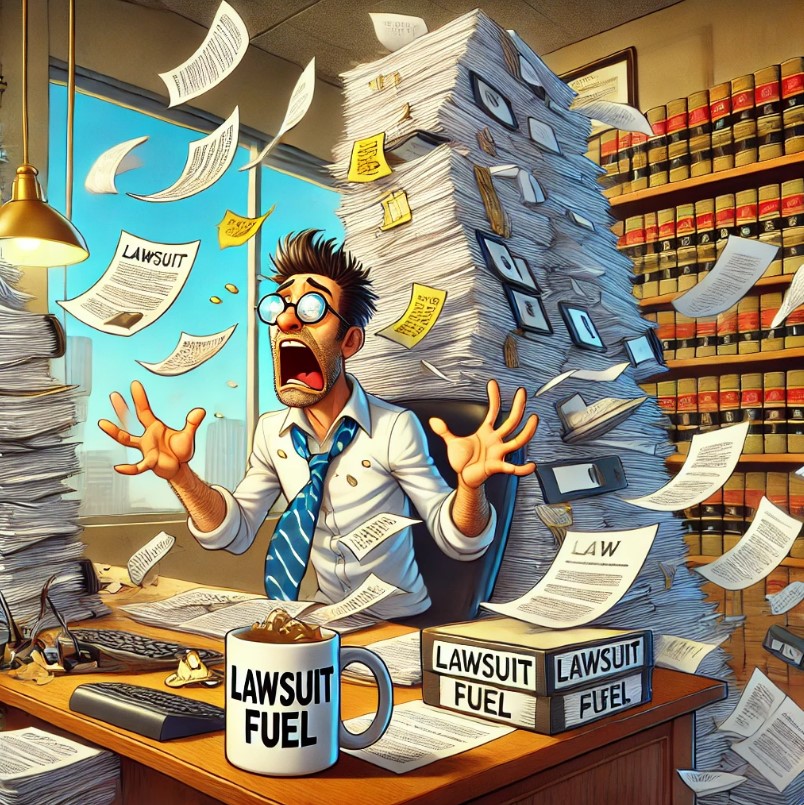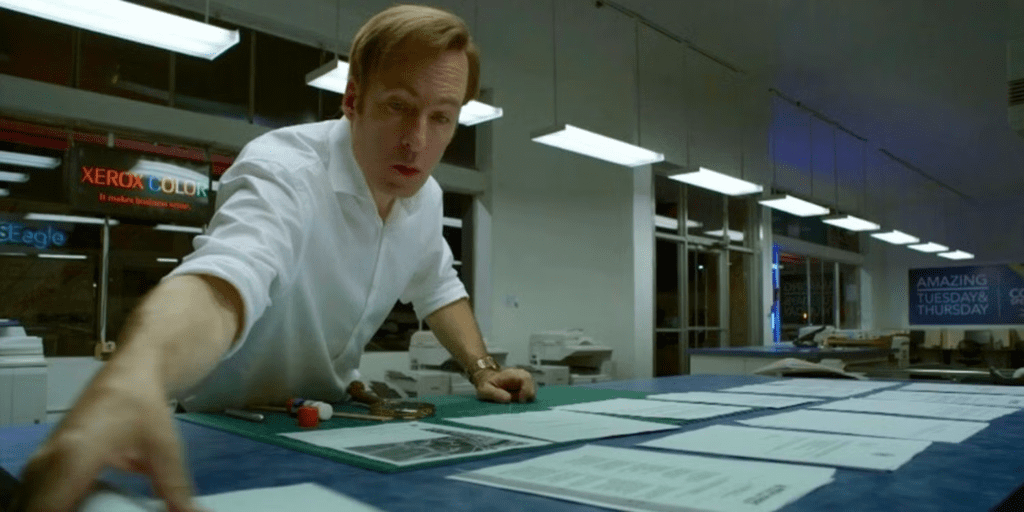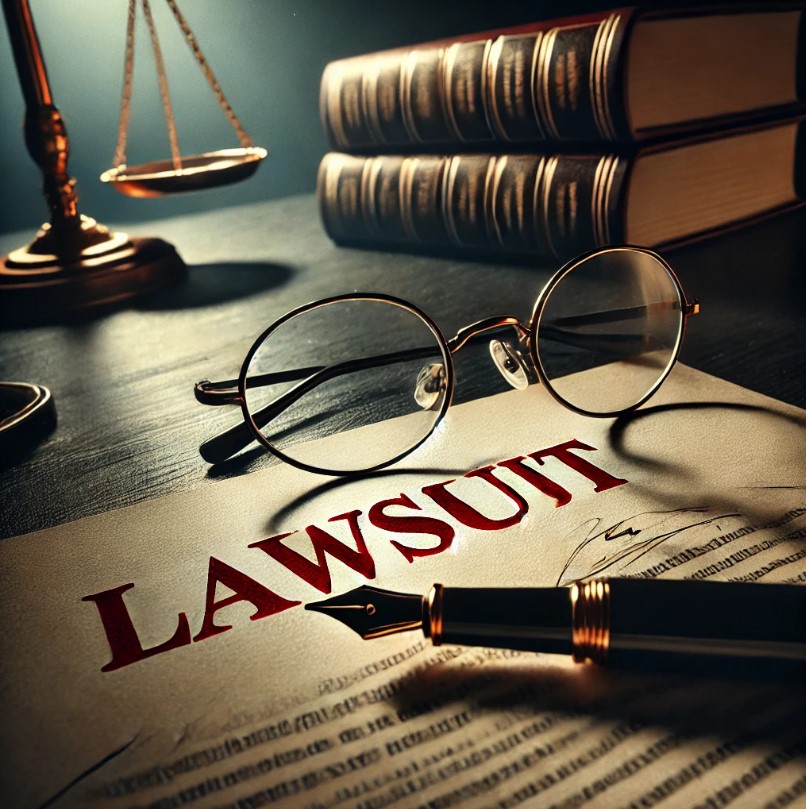The Lifespan of a Lawsuit: Start to Finish
Do you remember when The Hobbit trilogy came out and you wanted to sue MGM Studios and New Line Cinema for it? Or do you remember when you wanted to sue your 6th grader crush for saying, “gross,” very loudly in front of everyone after reading your love note to her? Well, in either of those very legit and favorable-to-you cases, did you ever wonder how long it would actually take to collect on your emotional damages?

How long does it take to file a lawsuit and finally collect?
What is the Timeline of a Lawsuit?
- Pre-Litigation: Weeks to Years
- File Complaint
- Answer Complaint: A Month
- Scheduling Order
- Discovery: 6 months to multiple years
- Pre-Trial / Attempt to Settle: three months to a year
- Trial: A Few Months
- Appeals: A Few Months to Multiple Years
- Judgment Collection
Follow these 9 easy steps to collect cash from when the O’Hare Airport bathroom was too stinky for you to enter long enough to relieve yourself, thereby causing you emotional hardship.
Let’s go through the list. Note, this isn’t some formal 9 step process. You could probably classify these into as simple as: Initial Complaint, Discovery, Trial, Judgment. I just broke it up into specific enough parts to help me describe them best.
Complaint vs Lawsuit
First – just to clarify, the complaint is what a lot of people probably think the lawsuit is. The lawsuit is the entire legal process that follows once a complaint is filed in court. The complaint is the legal document that initiates the lawsuit once it’s filed in court. So if you’ve ever seen the multipage document that has the claims, the demands, the parties involved, the details, etc. – that’s the complaint.
The complaint will include:
- A Caption which is the heading detailing the court, jurisdiction, plaintiff name, defendant name, and case number assigned by court.
- Introduction which describes the parties and their relationship to each other: employer-employee, landlord-lessee, business-customer, etc
- Jurisdiction and Venue which explains why this court has the legal authority to hear the case. So, state or federal and which county or district.
- Statement of Facts which is the point-by-point background of the case. This gives all of the specific details and facts of what happened
- Causes of Action/Legal Claims which is the specifics of what happened that the court can try the case for: negligence, fraud, breach of contract, etc. Also the legal basis will be stated as well meaning is there a statute at play or is this being based off of common law.
- Relief Requested which is what is being requested from the lawsuit. Are you asking for money, an injunction by the court, etc.
Phase 1: Pre-Litigation: Before the Complaint
This is where, at a minimum, you bring your case together. There’s more things that CAN be included in this step, but here is where you’ve decided you want to go ahead with a lawsuit so you start to gather evidence, receipts, review contracts, consult with experts, etc. You’re going to compile everything into a coherent idea/plan to go forward with.
There are many reasons you can be sued. One of which is if you get an ADA lawsuit for your website not being in compliance. Better yet, let’s stick with the situation below:
Let’s say you’re at a local hardware store and while walking through the lumber aisle, an employee on a forklift negligently bumps the rack and you get hit by falling 2x4s. You end up having to go to the hospital and get $50,000 in medical fees, you can’t work for 6 months, and you now are afraid to be around wood so you had to move to a concrete bunker because of your emotional distress.

The Pre-Litigation phase would be you getting all of your medical receipts together, compiling doctor’s notes saying that you are unable to work, notes from your employer that you’ve been laid off due to not being able to work, the receipt from breaking your lease early from your new lumberphobia, and your psychologist bills that you racked up after the incident.
Demand Letters and Settlement Negotiations: Still Phase 1, but Not Necessary
Additionally before you formally file the complaint (the lawsuit) with the courts, you can try to resolve ahead of time. As the plaintiff you can send a request to the defendant for resolution. You can say something along the lines of “hey, all of the damages you caused me total up to $250,000. Give me that or this will result in legal action.”
The recipient can respond and accept, request settlement negotiations, or ignore the letter. Settlement negotiations are when both parties will go back and forth and try to land on a favorable number that both will be happy with to avoid a lawsuit.
Phase 2: File the Complaint and Serve the Complaint
So, let’s say you went the route of sending the demand letter. You gave 60 days for a response, and you got ghosted. It’s time to begin the lawsuit by formally filing the complaint with the court.
You can file electronically, by mail or in person at the clerk’s office. Filing the complaint is getting it to the court somehow, paying the filing fees, and getting a case number. You will also get a court-issued summons and stamped copies of your complaint for record-keeping. Now, the defendant needs to be informed of the lawsuit by providing a copy of the complaint as well as a court-issued summons.
Service of Process
Service of Process is the phrase for when you are formally and verifiably notified of the lawsuit. This is a requirement of the lawsuit process. It MUST happen for things to go forward which is why the occupation of process servers is a thing. The Service of Process can be done by a third part (process servers), a sheriff, or another appointed member of the court, certified mail with return receipts, substituted service if someone else can sign for it, or publication if the person can’t be reached by any of the other methods. Any of these methods require a Proof of Service document to be filed with the court.
PS – Process Servers are the people that try to get you to sign for the lawsuit. You have probably seen depictions in TV and movies of someone dressed up as a UPS driver or some other profession in order to get the defendant to sign off on a package. Once they do, the server has a signature that the person is who they say they are, and they can be served properly thereafter.
Pic below from Pineapple Express depicting Seth Rogan’s character as a process server.

What if the Service of Process isn’t completed correctly?
Many people will try to dodge Service of Process to buy time, or they may think they can get out of the lawsuit entirely by never getting served. That won’t happen, but as stated above, mishaps in the execution of Service of Process could mess things up for the plaintiff later on. The Proof of Service is required to be filed with the court for any further steps to take place. Also, the statute of limitations could expire if enough time goes by. So, personally, I understand the desire to dodge it and hopefully delay/screw it up, but you’re probably better off getting an attorney and drafting a defense.
On the negative side, if you outright refuse service, the court could find a default judgment against you. This means the the case can continue without you and the plaintiff can win without your participation. You could be found in contempt. Some states have criminal penalties for refusing service. I would say the negatives far outweigh the odds, but that’s a decision for you to make.
Phase 3: Answer the Complaint
As the plaintiff, obviously you don’t have to do anything during this. As the defendant, you must respond to the complaint within a specified amount of time (20-30 days being determined by the jurisdiction). This means the defendant needs to get an attorney as fast as possible to get a quality response drafted up.
There are a number of ways you can respond, but some of the most popular:
- File an answer addressing each claim.
- In this process you are admitting, denying, or saying you have no idea what this complaint is talking about.
- You can raise counterclaims in an answer as well.
- File a motion to dismiss
- When filing a motion to dismiss, you are saying “this case needs to be thrown out entirely.”
- You would do so by raising a defense. You’ve heard of some of these:
- Improper venue
- Lack of jurisdiction
- Insufficient service of process
- Statute of limitations
- File a motion to strike
- This is when you remove parts of the complaint that are irrelevant, legally invalid, or scandalous
- Does NOT throw case out, just aspects of complaint
- File a counterclaim
- Request an extension
- Negotiate a settlement
- Many more exist
The term initial pleadings refers to the complaint and response once they’ve been officially filed with the court.
Phase 4: Scheduling Order
The scheduling order is basically a game plan of the entire lawsuit. It has procedural steps along with deadlines for each. The scheduling order is issued after the initial pleadings are filed and after an initial court date is attended. Depending on jurisdiction, this first appearance is called different things like an initial scheduling conference for federal courts or any number of different two to three letter titles for state courts: CMC, PC, DC, etc.
An initial scheduling conference (ISC) will set deadlines for discovery, motion filing, and trial prep. The whole plan is to end with an issued scheduling order. This is for federal cases under FRCP 16(b).
You would need to look at your specific state you’re filing in for a state case to see the exact terminology and what to come prepared with. An initial case management conference is a fairly common term for many states – “an initial CMC” to set a scheduling order.”
This scheduling order is open to motions for extensions meaning the timeline could change depending on certain circumstances. This is generally why the discovery phase is so long. One party will ask for an exorbitant amount of material that cannot feasibly be obtained in the timeframe. Said party will file a motion for an extension saying they need more time to get this evidence. Both sides will try to do the burdensome amount of information requested to bog down the other side.
Phase 5: Discovery
Discovery is exactly what it sounds like. This is where each side will have their chance to request information/evidence from the opposing party. This can include:
- Interrogatories
- This is a list of questions you send the opposing party that must be answered truthfully.
- Requests for Production (RFPs)
- This is a list of documents, emails, video, audio, reports, etc.
- Depositions
- Depositions are when there is a questioning of witnesses under oath which are recorded by a court reporter
- Requests for Admissions (RFAs)
- When you request the opposing party specifically admit or deny facts in order to narrow down the scope of the lawsuit if necessary
- Subpoenas
- This is a court ordered request for third parties to provide documents or testimoney. A party to the suit wouldn’t be subpoenaed beacuse they already are subject to the rules of discovery and must respond. A subpoena is to get outsiders to provide evidence.
- Expert Witness

This is really where the legal fees rack up and how one side can try to bury the other if they have more legal resources. This is why it’s usually a losing battle to be a small guy trying to sue a large corporation with unlimited legal funds. They will make it such a lengthy and expensive process in terms of legal fees and discovery that it would be cheaper for you to just back out of the suit.
First Hand Experience In This
I helped an ecommerce business that I worked for (plaintiff of an IP lawsuit) answer all of the interrogatories and RFPs provided by the defendant of the IP lawsuit. Some of the requests were requesting all order data from every order that we have ever had. The lawsuit was IP violations about 12 months prior. The request was for orders dating five years back. This was legitimately not doable without dedicating someone to the task for their entire job.
Additionally they would request the contact information of every single third party company we’ve worked with. This means manufacturers, apps that we use, services we’ve used, marketing agencies we’re used, etc. Completely overbroad and burdensome. Our attorney responded to some of those using that exact language to get them removed.
If one party refuses to answer, the opposing party can file a motion to compel which would demand, per the court, that the answer be provided. There can be a motion for protective order in which the information is available, but should be refused due to sensitive information disclosures. Also, there can be sanctions requested for discovery violations where courts can penalize for destroying evidence or withholding evidence.
As you can tell, discovery is a battle.
Phase 6: Pre-trial and Attempt to Settle
The goal here is to avoid trial for both parties. At this point, discovery has concluded and all of the pertinent facts and evidence are on the table. Both sides can make an educated decision on how they think they’ll fair if it goes to trial. Depending what was uncovered, the balances may shift.
If there is no agreement on a settlement, then it’s time to prepare for trial.
Phase 7: Trial – A Few Months (Sometimes)
Alright, you’ve done the dance—evidence has been exchanged, everyone’s annoyed, and your attorney now responds to emails with one-word replies like “Noted.” Welcome to the trial phase.
The trial is where it all goes down. You get your courtroom drama moment. But, spoiler alert, it’s not always as thrilling as it is on TV. It’s just a lot of procedure, objections, and strategically boring arguments.

Here’s what actually happens:
- Jury selection (voir dire): A fancy French term for “Let’s figure out who here hates everyone and can’t be impartial.”
- Opening statements: Each side gives their version of “Here’s what you’re about to see, but trust me, our story is better.”
- Presentation of evidence: Witnesses are called, documents are shown, people say “Objection!” a lot. This is the meat of it.
- Cross-examination: Attorneys try to poke holes in the other side’s testimony—sometimes successfully, sometimes awkwardly.
- Closing arguments: Each side wraps it up with their best spin on the facts.
- Jury deliberation: The jury disappears for a while and argues in a room with bad coffee until they come to a decision. If it’s a bench trial (judge-only), the judge decides.
Trials can last anywhere from a few days to several weeks or months, depending on the complexity. Think “slip and fall while dumpster diving at Denny’s” vs. “multinational corporation poisoned a river.” Big difference.
Then, a verdict is reached: liable or not liable (in civil cases), and if liable, for how much. This number may or may not be what you were hoping for.
Which brings us to…
Phase 8: Appeals – A Few Months to Several Years
So you lost. Or maybe you won, but the other side is salty and decides, “Let’s keep this party going.” Welcome to the appeals process—where we argue not about what happened, but whether the trial was legally done right. So, this isn’t about facts of the case, it’s about the procedure. Were technical aspects of the case done incorrectly that would have caused it to potentially have a different outcome?
Key thing to understand: Appeals are not do-overs. No new evidence, no new witnesses, no new sob stories. It’s just a bunch of lawyers arguing over whether the judge misapplied the law, allowed something they shouldn’t have, or totally flubbed jury instructions.
Here’s how it goes:
- The losing party files a Notice of Appeal pretty quickly after the judgment.
- Then come the appellate briefs—essentially, long legal essays that say, “Your Honor, here’s why that judge botched it.”
- The other side responds with their own brief: “Nah, everything was fine.”
- Sometimes there’s oral argument, where lawyers show up and answer questions from appellate judges who may or may not have read the briefs in full.
- Then you wait. Could be months, could be years. Seriously.
Possible outcomes:
- The appellate court affirms the original decision (so… nothing changes).
- They reverse it (now the loser is the winner).
- They send it back down for a new trial, often with specific instructions.
In short: Appeals are long, expensive, and very technical. But they’re important when legal mistakes may have changed the outcome.
Phase 9: Judgment Collection
So you won. You defeated the dragon, made it through the procedural maze, and a judge awarded you a giant pile of cash. Congratulations! But here’s the kicker…
That doesn’t mean you automatically get paid.
The court doesn’t act like a collection agency. If the person or business you sued doesn’t voluntarily pay up (and often, they don’t), it’s up to you to go get that money.

Here are your options:
- Writ of Execution: This gives you permission to seize property or assets. Yes, you can technically have the sheriff go grab their car, bank account, or that vintage pinball machine they love.
- Wage Garnishment: You can ask the court to take a portion of their paycheck directly.
- Bank Levies: You can freeze and collect funds directly from their bank account. Surprise!
- Liens: You can file a lien against their property so that if they ever sell it, you get paid first.
- Post-judgment discovery: You can make them disclose their assets. If they lie, it’s perjury. If they don’t respond, you can drag them back to court.
Fun fact (not really): Collecting a judgment can take just as long—or longer—than the lawsuit itself, depending on how hard the defendant wants to make it.
And yes, judgments can accrue interest, so if they stall long enough, you could technically get more… but most people would rather just get paid and move on with life.
Conclusion
So, yeah… suing someone isn’t exactly a quick “file and win” type of deal. It’s more like entering a slow, expensive obstacle course filled with deadlines, legal jargon, coffee-fueled arguments, and occasional psychological warfare via email threads. But if your case is strong and your patience is stronger, you might just come out the other side with a judgment in your favor—and hopefully, an actual check. Just remember: winning in court is only half the battle… the other half is figuring out how to collect without losing your mind (or your lunch).


